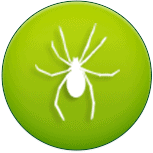Let’s Talk Ticks
In recent years, the National Pest Management Association (NPMA) is expressing concern regarding a national increase in ticks. Following a research study consisting of a sample group of 274,500 Americans between January 2018 and May 2019, it was found that there was an 11.4% spike in tick problems. Meanwhile, the Centers for Disease Control and Prevention (CDC) reported that annual cases of tickborne diseases have doubled from 2004 to 2018 and, throughout these swells in infection rates, scientists even identified 7 new tickborne diseases. Unfortunately, these tick problems have only continued to increase, making tick protection more important than ever.
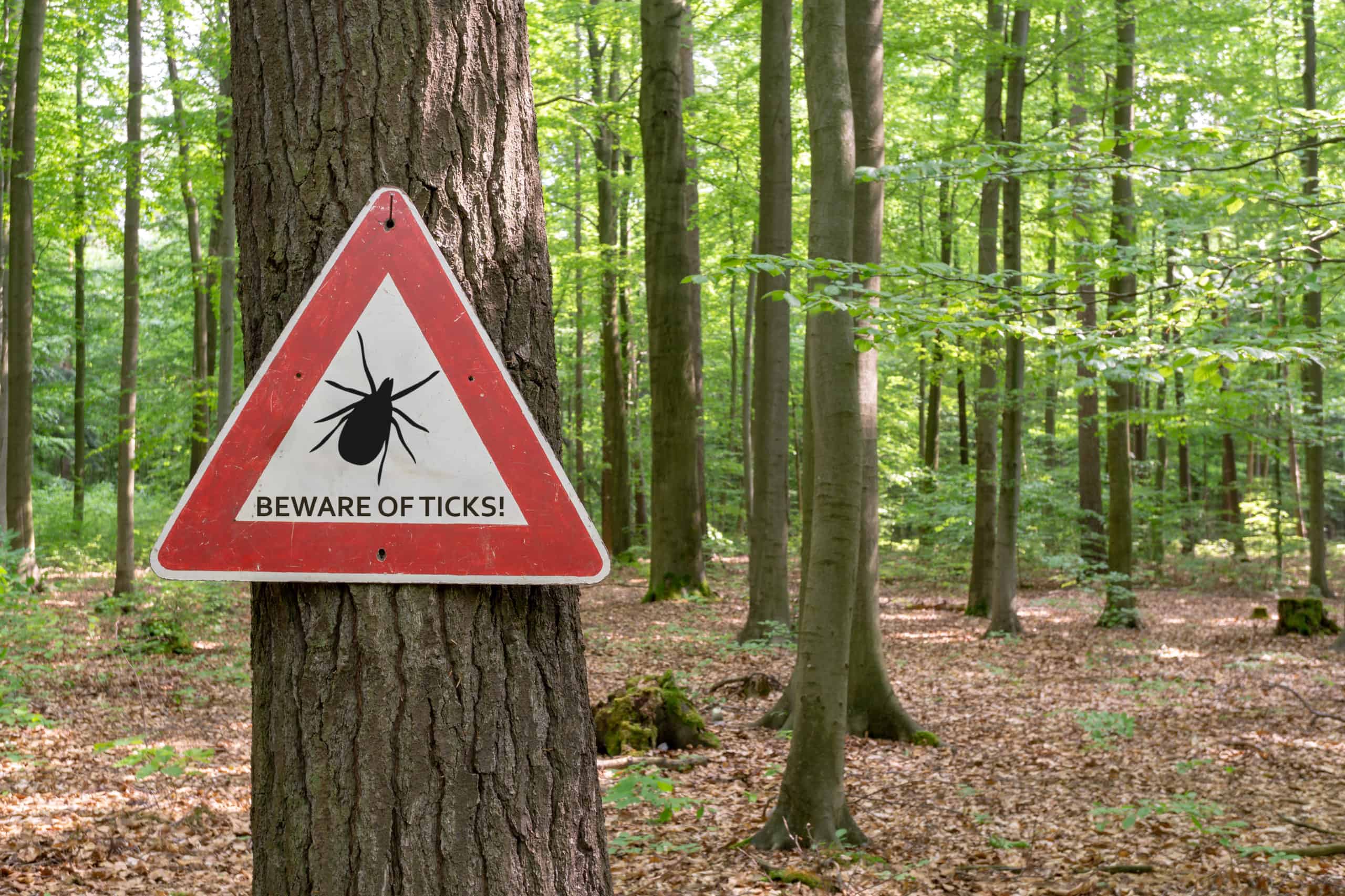
Let’s Get Started
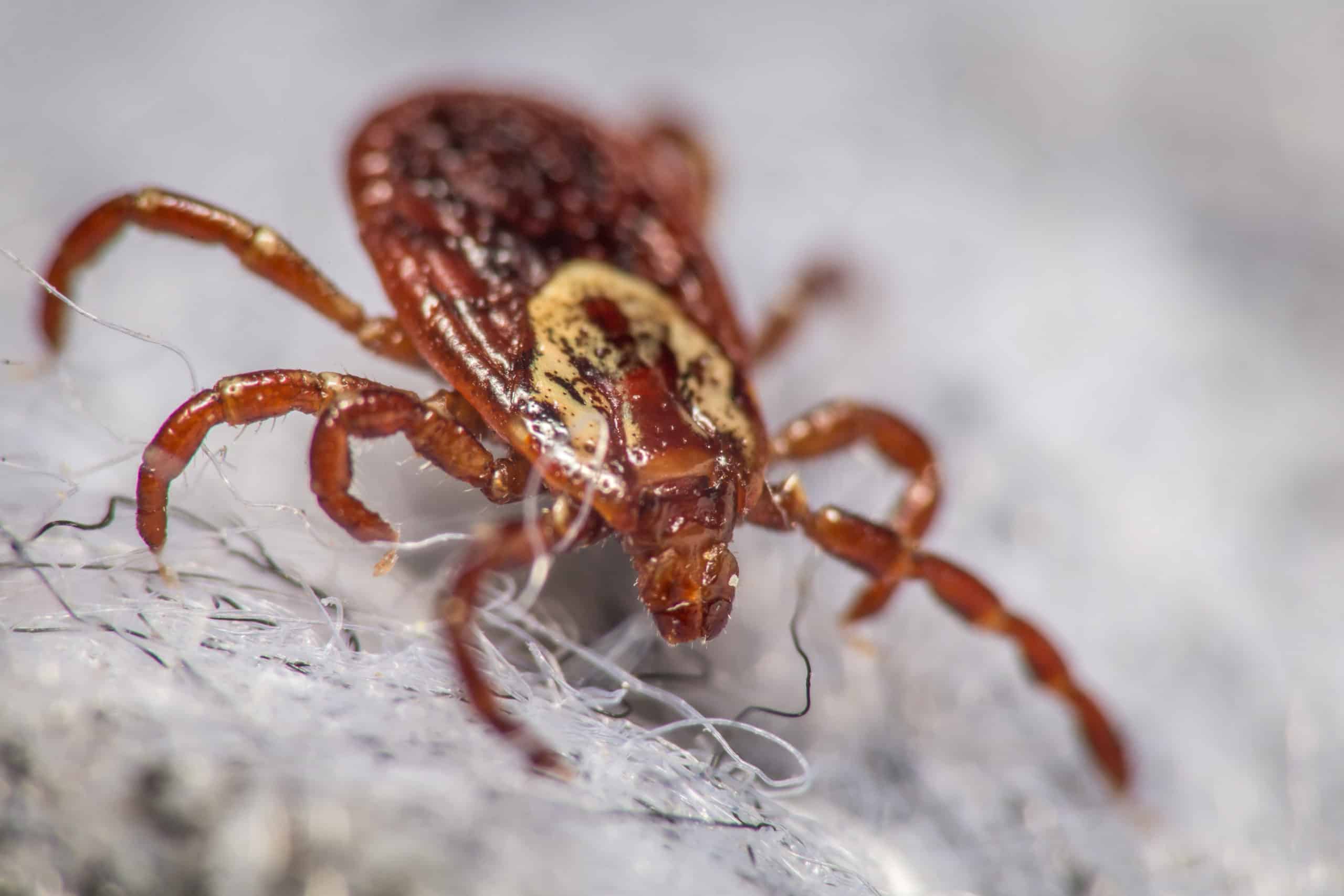
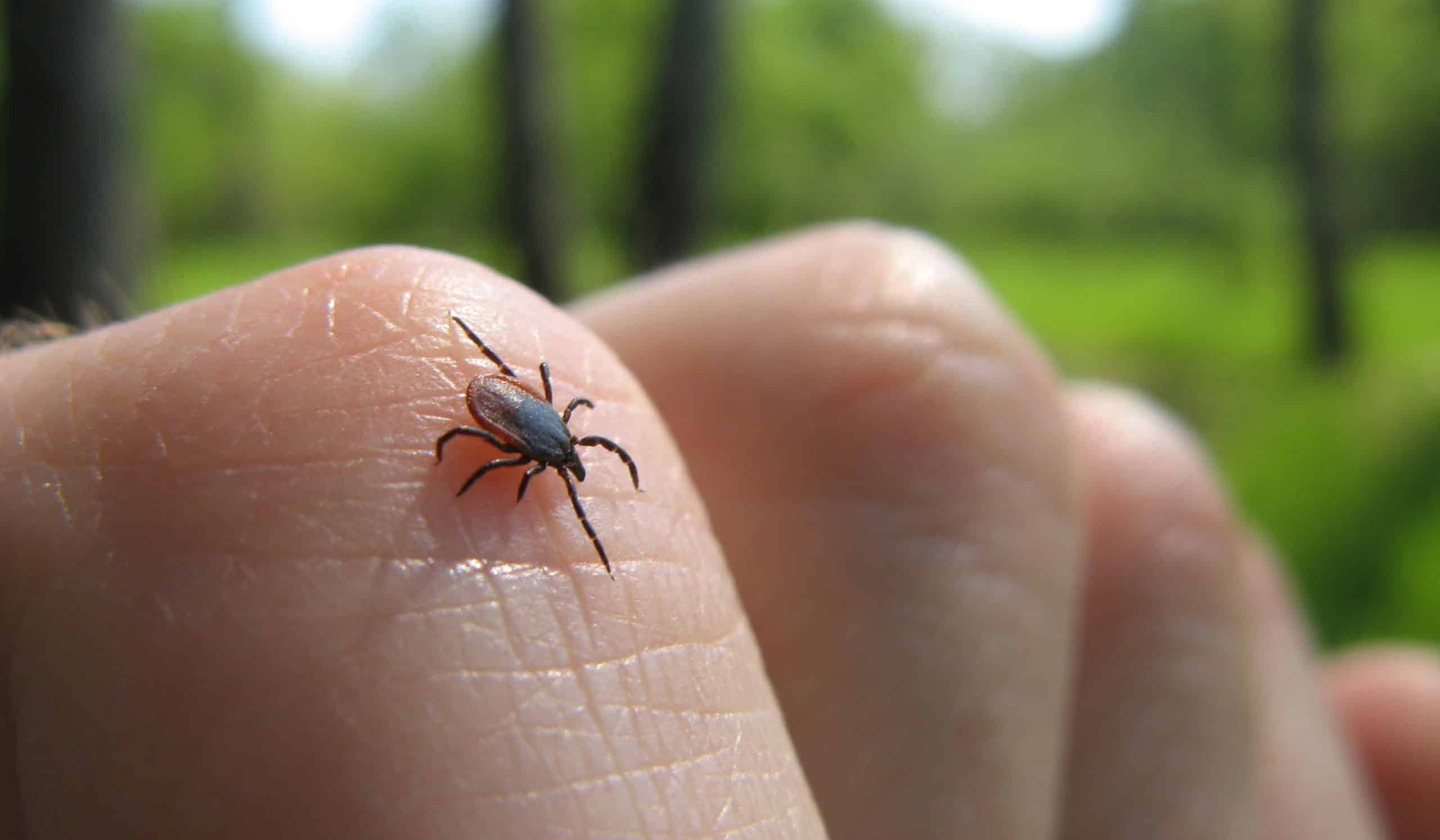

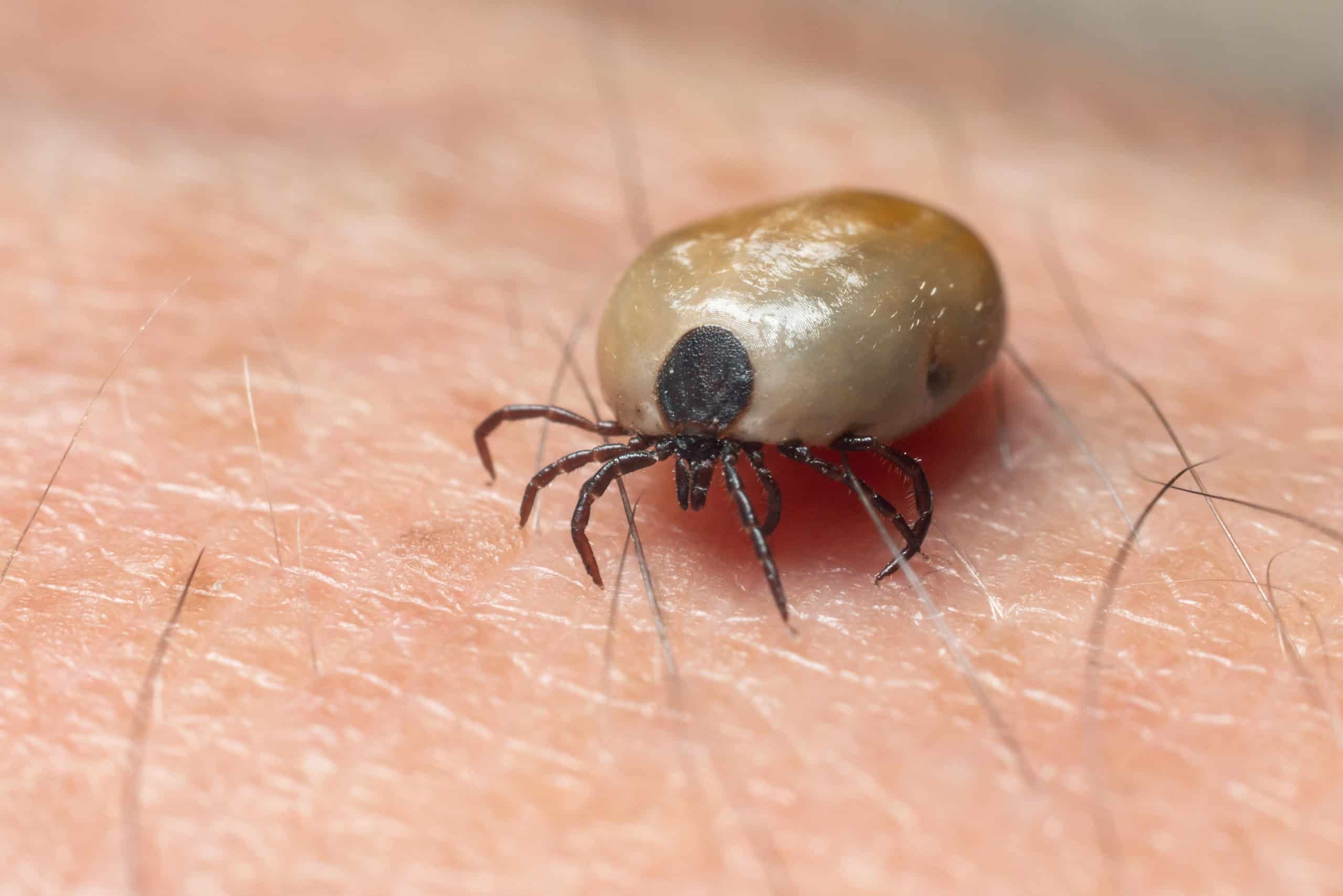
Terrible Ticks
Ticks are part of the class Arachnida. They have eight legs, simple eyes (instead of compound eyes), lack antennas and wings, and have segmented bodies broken down into two parts (unlike the three in insects). They are also ectoparasites (or ‘external parasites’) that both live and feed outside of their hosts and, unfortunately, we are often their preferred hosts.
Ticks lack the abilities to fly and jump, but, they are expert climbers and will use this skill to their advantage to find hosts. Climbing to the top branch of a bush, the end of a blade of grass, or the side of trees, the ticks will sit in rest, raising their front two limbs into the sky. These creepy, spindly arms have sticky pads at the ends of them, which they use to grab on to their unsuspecting victims.
Once a tick has found a host, they split open the skin of their victim and insert their heads with a barbed, straw-like appendage sinking into the flesh. This makes them difficult to remove and, while it sounds painful, the saliva of ticks contains a local anesthetic that numbs the area, making the host unaware of the attacking parasite. This saliva also contains an anticoagulant so that the blood does not clot and continues to flow, along with suppressants for the immune system so that the body cannot respond by creating a large itchy bump or any other sort of reaction that would clue a host into their presence.
Unfortunately, these bites can also carry a variety of horrible diseases and, no matter what stage of life they are in, ticks can transmit pathogens to their hosts.
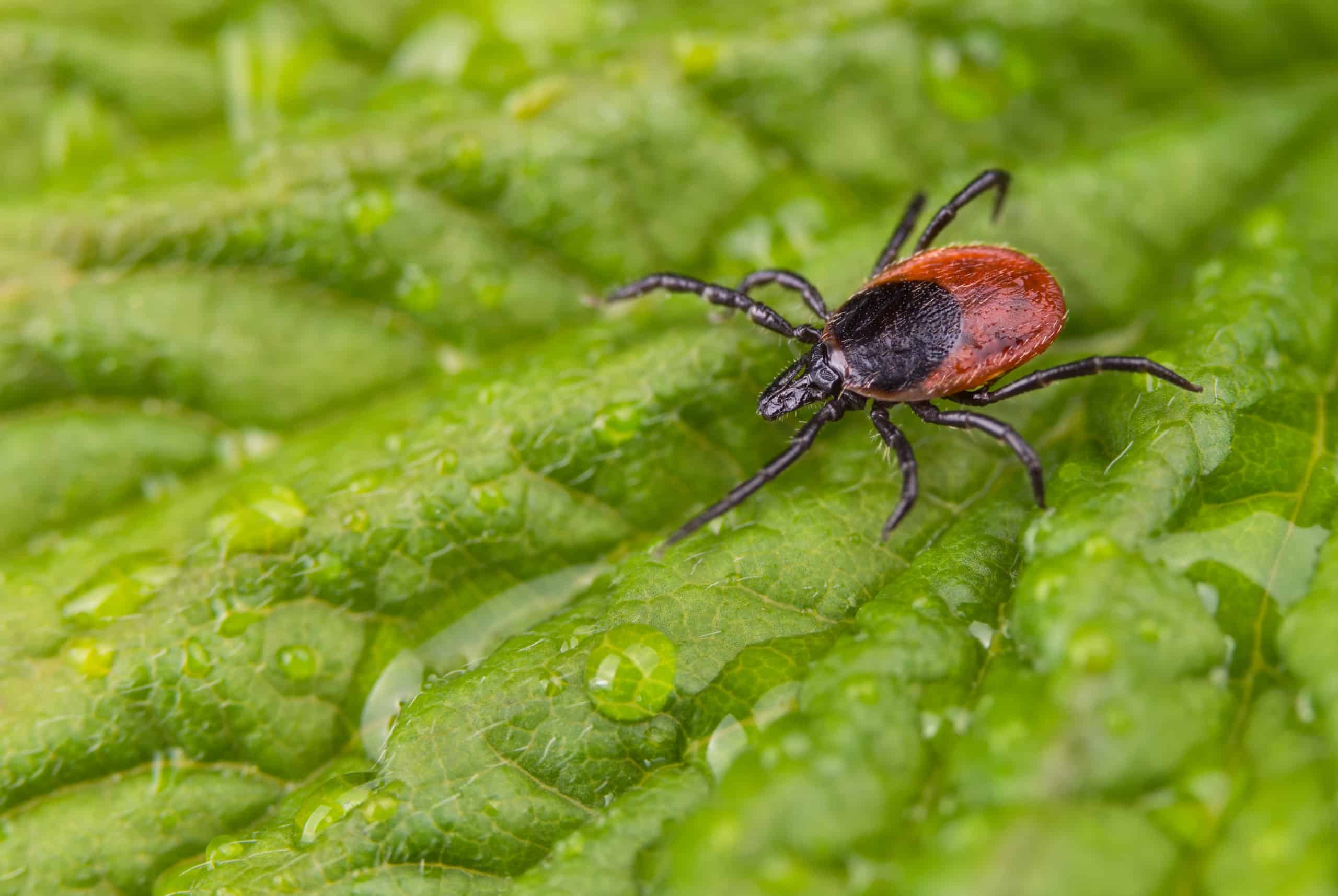
Terrible Ticks
Ticks are part of the class Arachnida. They have eight legs, simple eyes (instead of compound eyes), lack antennas and wings, and have segmented bodies broken down into two parts (unlike the three in insects). They are also ectoparasites (or ‘external parasites’) that both live and feed outside of their hosts and, unfortunately, we are often their preferred hosts.
Ticks lack the abilities to fly and jump, but, they are expert climbers and will use this skill to their advantage to find hosts. Climbing to the top branch of a bush, the end of a blade of grass, or the side of trees, the ticks will sit in rest, raising their front two limbs into the sky. These creepy, spindly arms have sticky pads at the ends of them, which they use to grab on to their unsuspecting victims.
Once a tick has found a host, they split open the skin of their victim and insert their heads with a barbed, straw-like appendage sinking into the flesh. This makes them difficult to remove and, while it sounds painful, the saliva of ticks contains a local anesthetic that numbs the area, making the host unaware of the attacking parasite. This saliva also contains an anticoagulant so that the blood does not clot and continues to flow, along with suppressants for the immune system so that the body cannot respond by creating a large itchy bump or any other sort of reaction that would clue a host into their presence.
Unfortunately, these bites can also carry a variety of horrible diseases and, no matter what stage of life they are in, ticks can transmit pathogens to their hosts.
The Most Common Ticks in Virginia
There are 17 different species of ticks known to inhabit both Virginia and Maryland. However, the following 3 ticks are the most common ones that you may come across:
The Black-Legged Tick / Deer Tick (Ixodes scapularis)
Appearance: The easiest way to distinguish a deer tick is through its dark black legs and the bright red-orange bodies of the females while the males are a brown/black.
Habitat: These ticks prefer areas of higher elevation and rather thickly bushy areas where they would come across deer and other wildlife. They search for victims from short/low vegetation, not trees and rarely travel over 3-4 feet off of the ground.
Life Cycle: After indulging in a blood meal, adult females can produce roughly 1000-3000 eggs at a time. But, as tick death rates are rather high due to predators and other external factors, a good portion of the eggs do not mature to adulthood. Eggs tend to hatch around June/July and by May, the larvae will molt into nymphs and begin feeding until they one again molt, this time into adults. These ticks not only survive through the winter months, but they remain active as long as temperatures do not drop below freezing.
Risk of Disease: The Deer Tick/Black-Legged Tick is infamous for transmitting Lyme disease as well as Human Babesiosis and Human Granulocytic.
The Lone Star Tick (Amblyomma americanum)
Appearance: Lone Star ticks are reddish-brown with hints of yellow. The females are generally larger than their male counterparts and have a distinctive white spot on their backs.
Habitat: These ticks like to hide either in the underbrush or along the edges of clearings or bodies of water.
Life Cycle: Lone Star female ticks deposit roughly 5,000 eggs after feeding on a host. The eggs undergo an incubation period before the larvae emerge seeking a host. The size of the ticks can vary throughout each stage depending on the environmental conditions and genetics. In general, the life cycle of Lone Star ticks lasts up to 2 years.
Risk of Disease: Unfortunately, the Lone Star tick has a very high rate of biting reports and even holds the record for most bites in the southcentral and southeastern United States. They are also known for carrying several different pathogens including Tularemia, Ehrlichiosis, Rickettsiosis, and even can cause Alpha-Gal Syndrome.
The American Dog Tick (Dermacentor variabilis)
Appearance: These ticks have dark brown bodies with an off-white color on their dorsal shield. The female’s off-white coloration is shaped somewhat like a half moon facing their heads, while the males have more of a mottled pattern on their backs. Normally, the ticks are roughly 5mm in length, but can extend to 15mm when engorged with a blood meal.
Habitat: Unlike the Lone Star tick or Deer tick, The American Dog tick avoids areas with heavy tree cover, instead opting to inhabit grassy fields, open meadows and areas with low vegetation that have a high traffic of animals.
Life Cycle: These ticks are extremely resilient and while their average life span is 2-3 years, adults can survive up to 2 years without even feeding. Mating occurs while the female is on the host, and after dropping off and laying her eggs, the female will pass away leaving her roughly 4,000-6,500 eggs to hatch in about a month’s time.
Risk of Disease: The American Dog Tick is the primary carrier of Rocky Mountain Spotted Fever – a terribly infectious disease. These ticks can also pass tularemia and even cause canine tick paralysis in our furry friends.

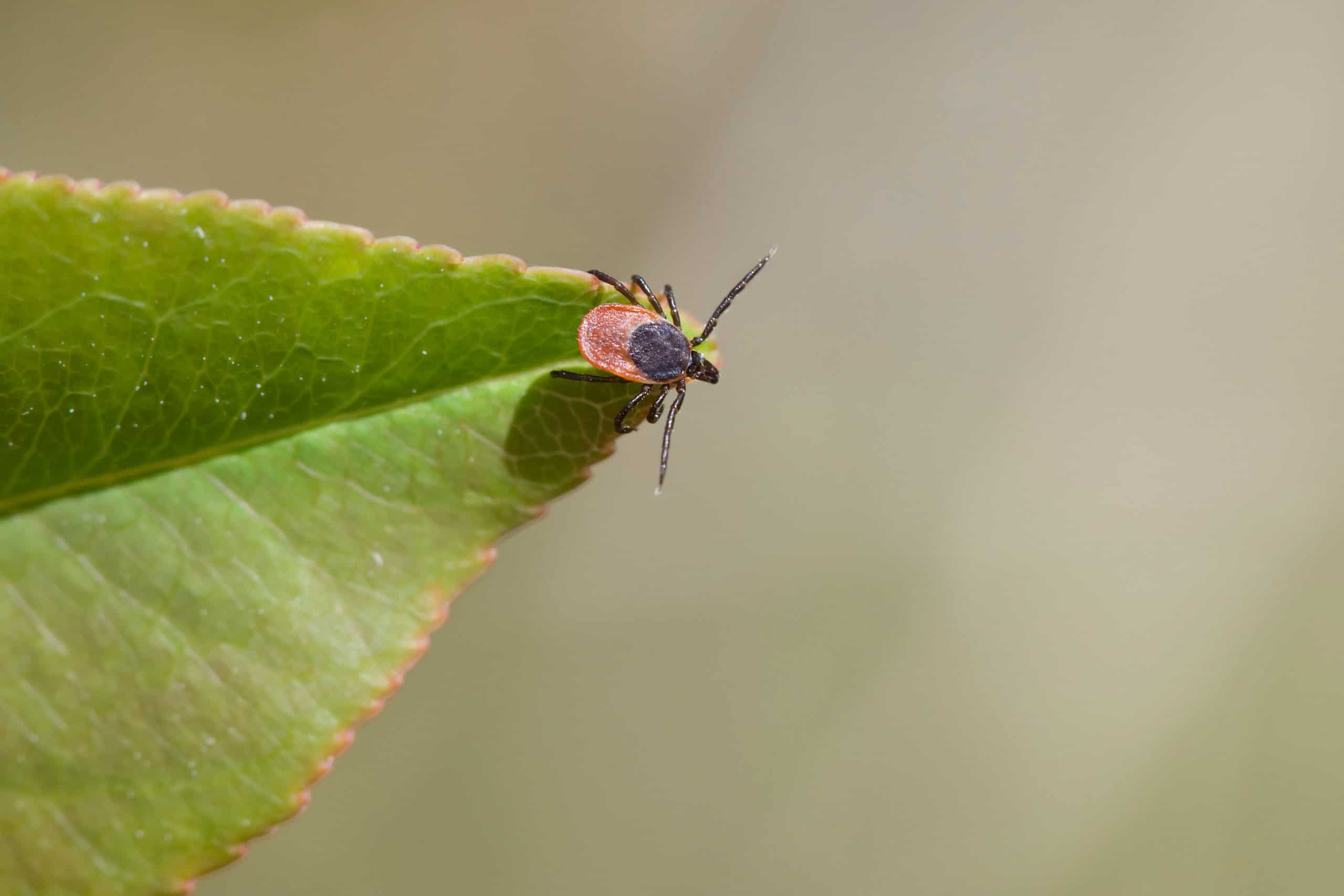
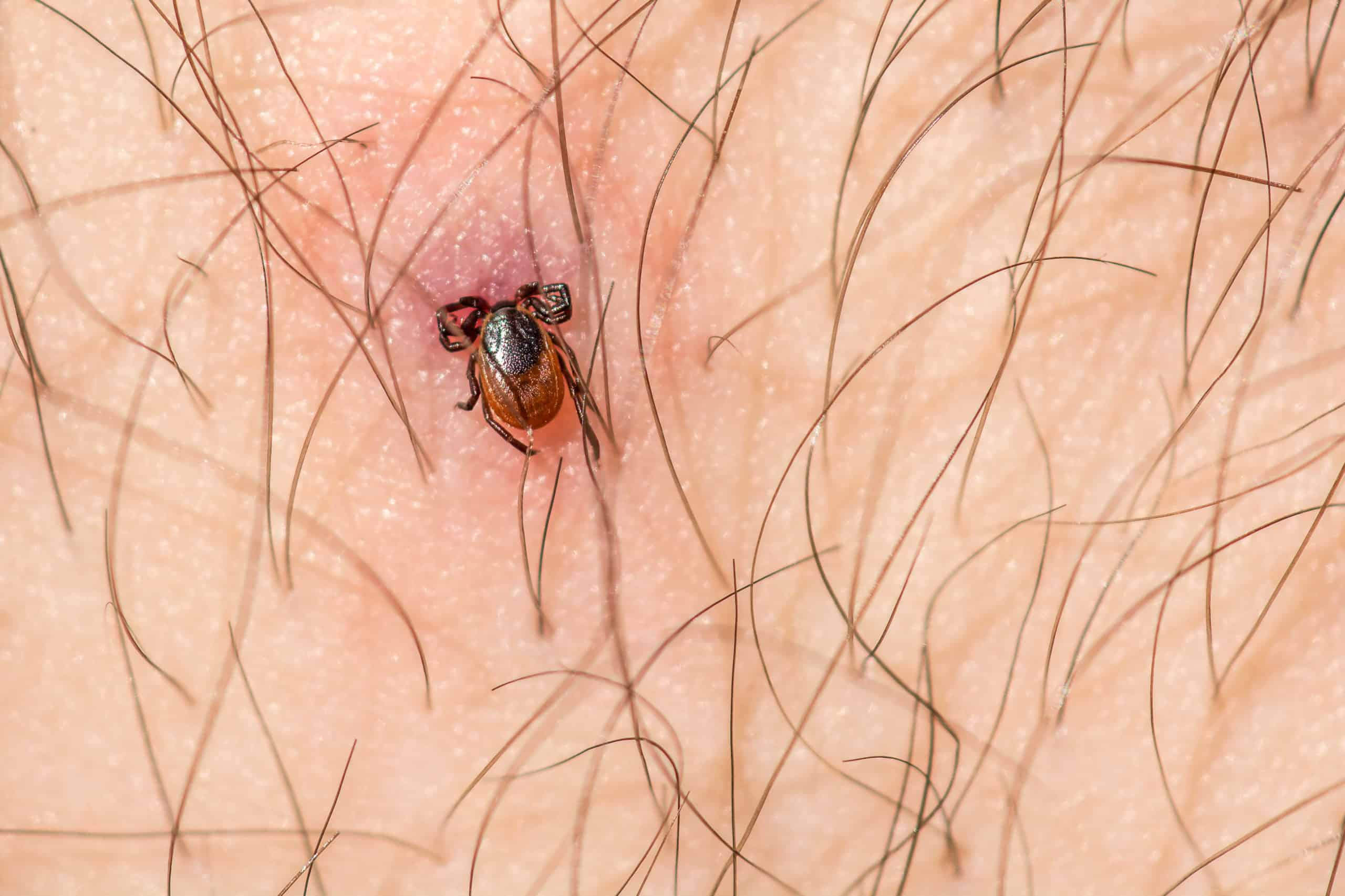
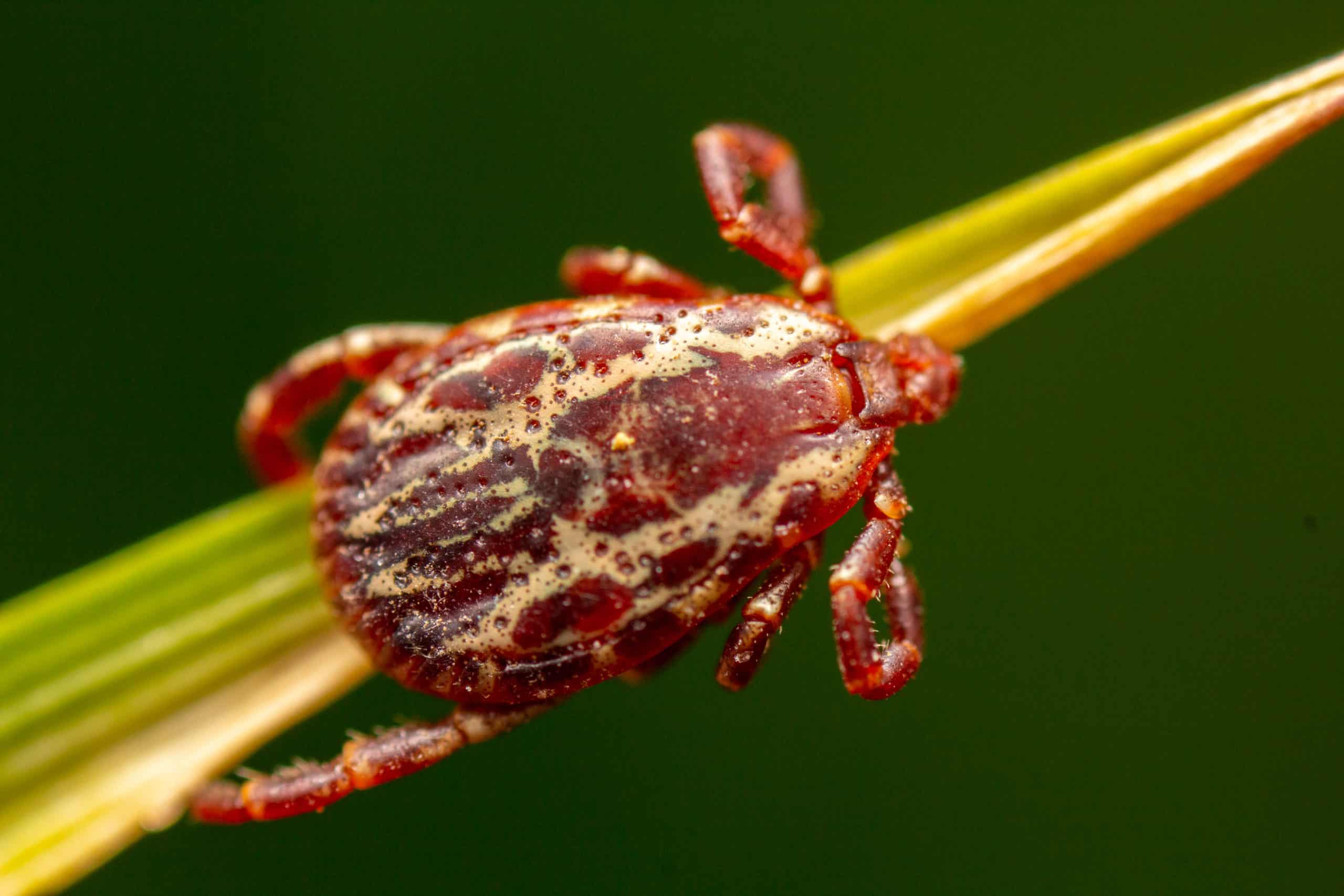
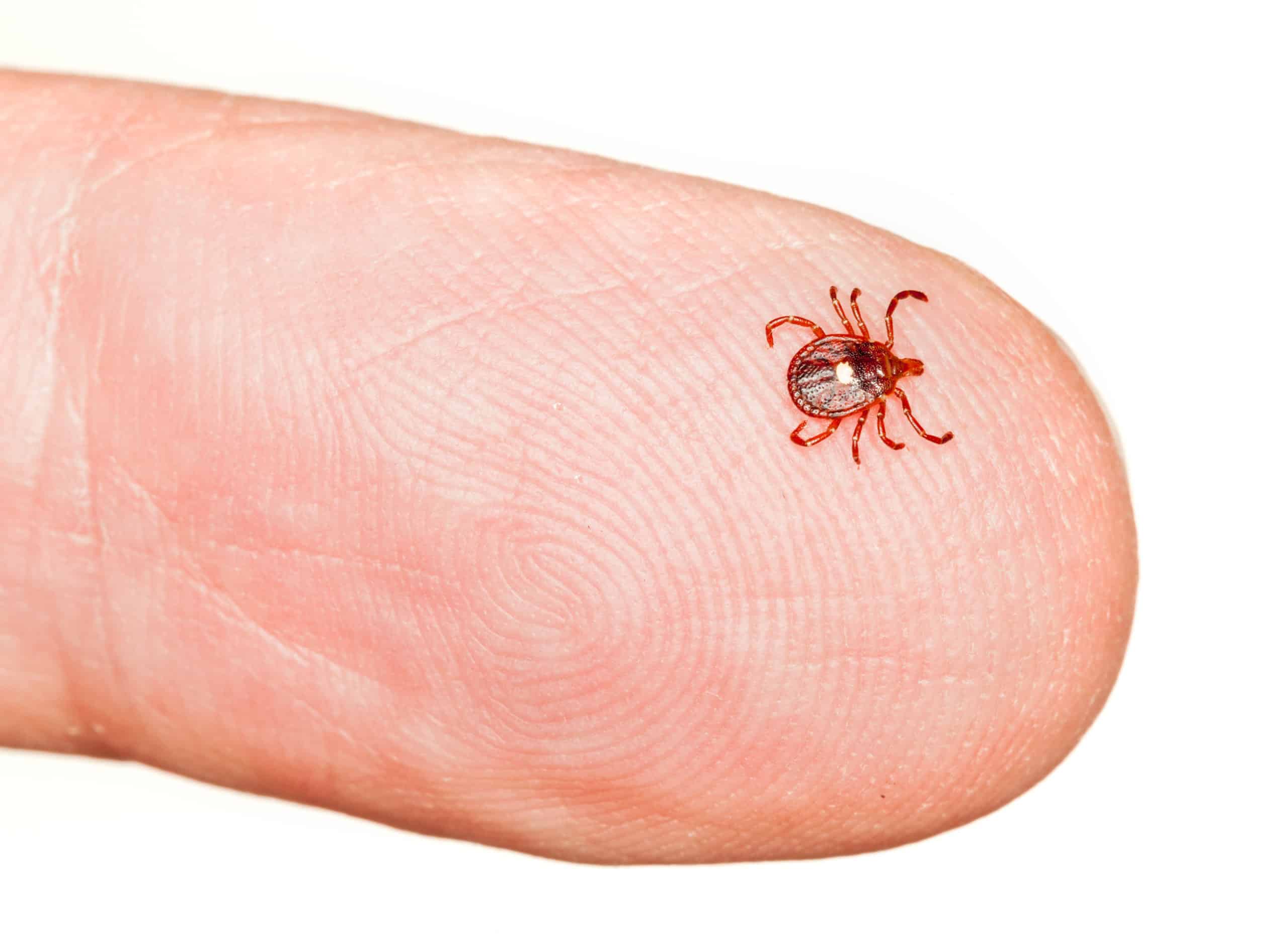
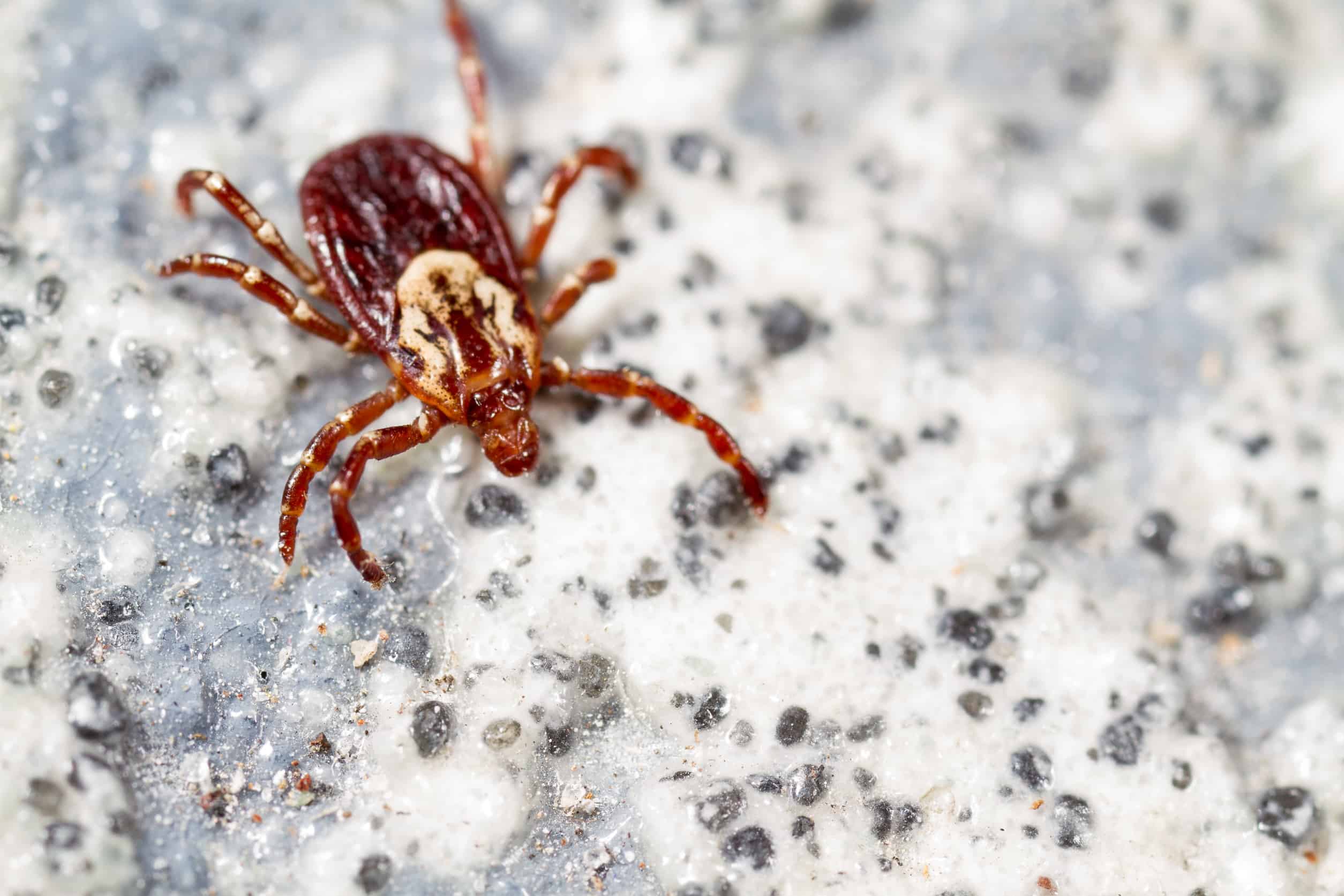
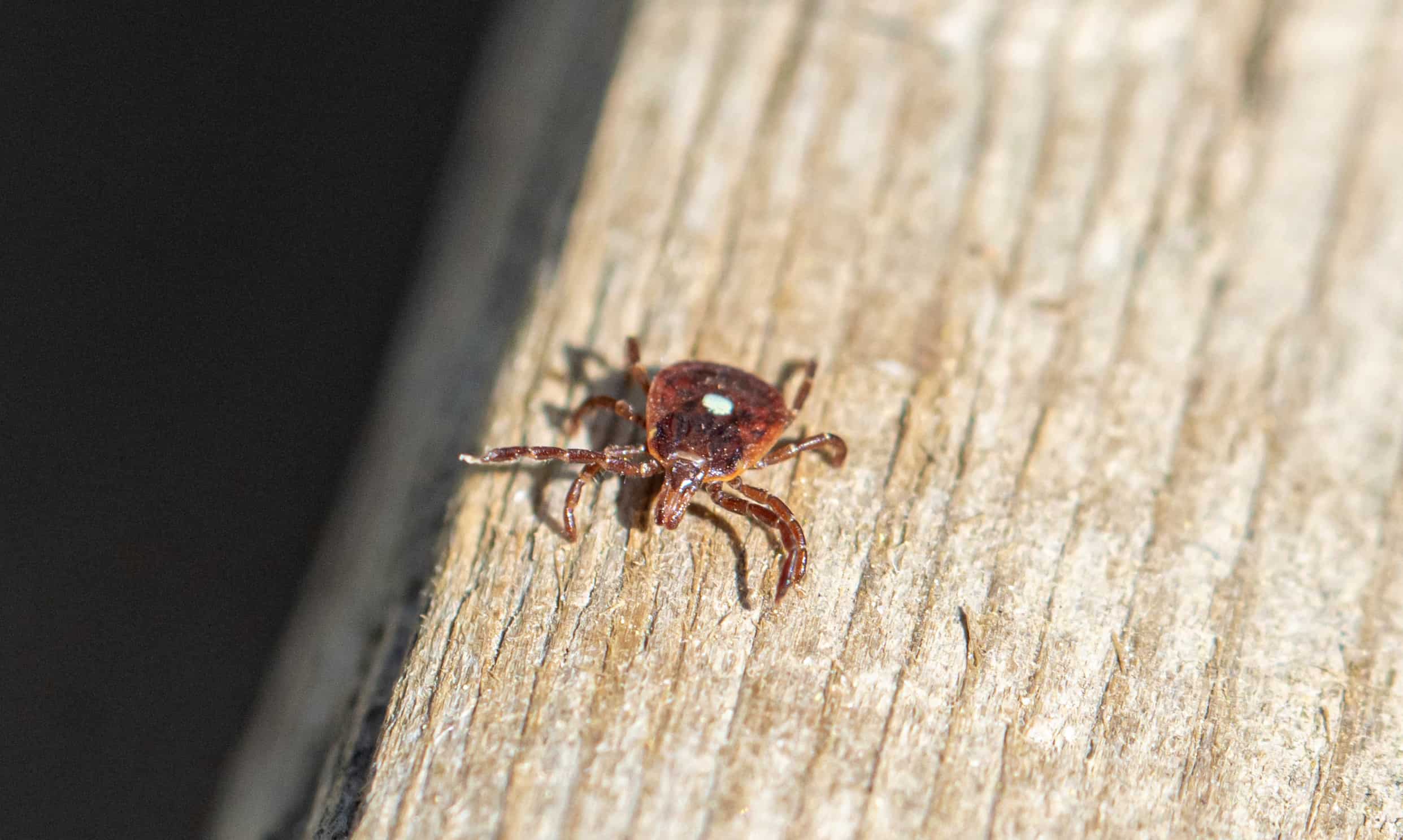
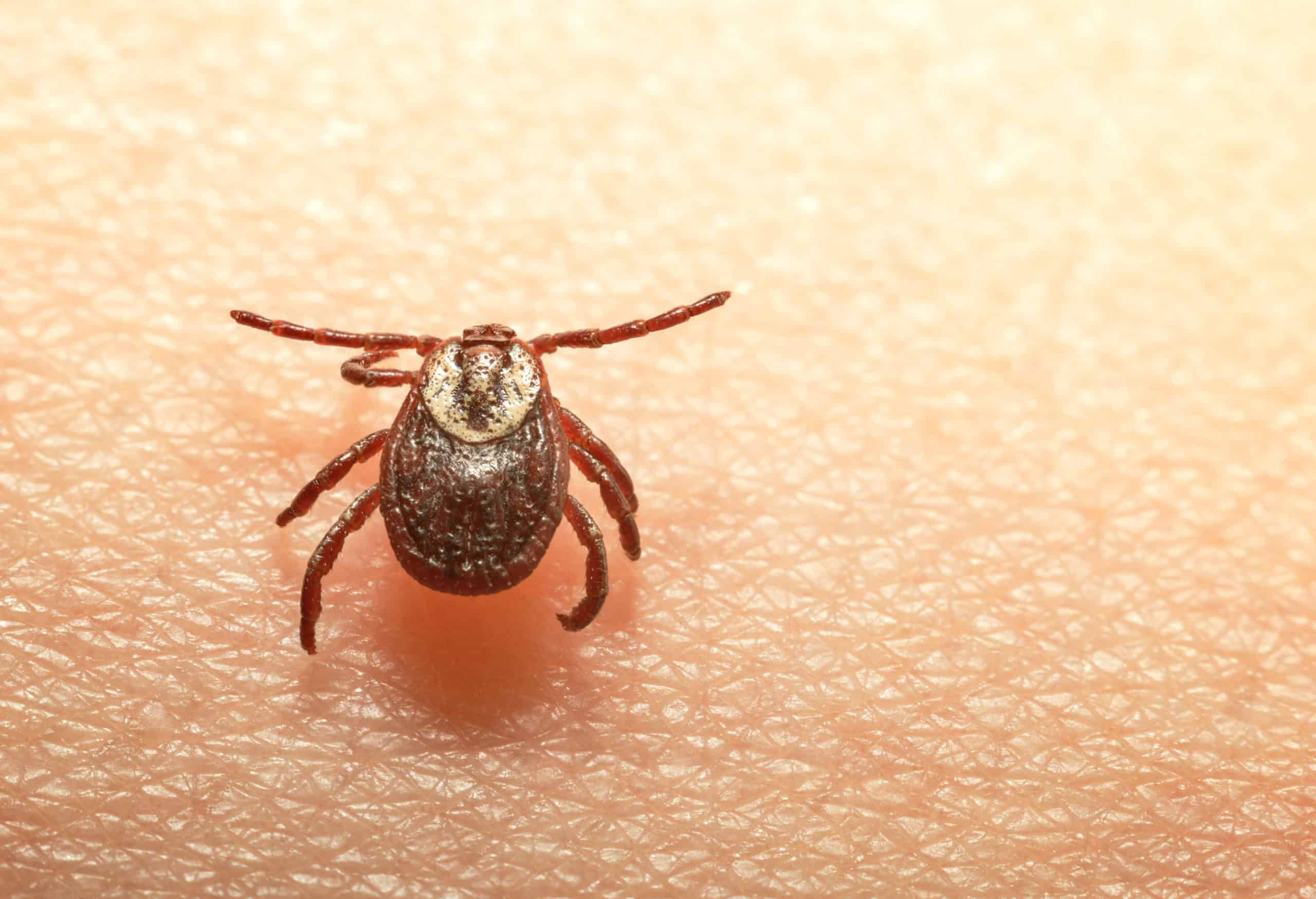
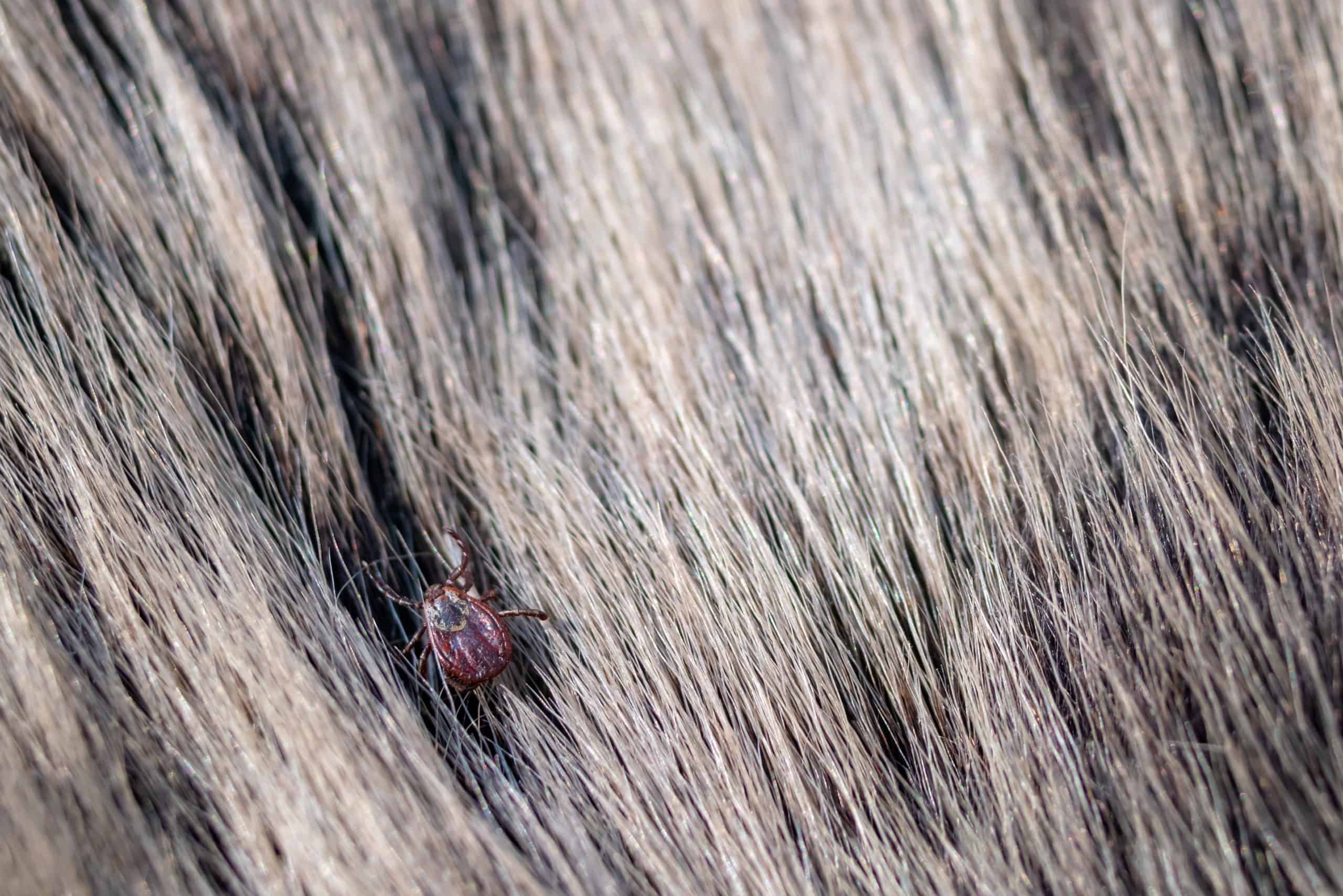

The Most Common Ticks in Virginia
There are 17 different species of ticks known to inhabit both Virginia and Maryland. However, the following 3 ticks are the most common ones that you may come across:
The Black-Legged Tick / Deer Tick (Ixodes scapularis)
Appearance: The easiest way to distinguish a deer tick is through its dark black legs and the bright red-orange bodies of the females while the males are a brown/black.
Habitat: These ticks prefer areas of higher elevation and rather thickly bushy areas where they would come across deer and other wildlife. They search for victims from short/low vegetation, not trees and rarely travel over 3-4 feet off of the ground.
Life Cycle: After indulging in a blood meal, adult females can produce roughly 1000-3000 eggs at a time. But, as tick death rates are rather high due to predators and other external factors, a good portion of the eggs do not mature to adulthood. Eggs tend to hatch around June/July and by May, the larvae will molt into nymphs and begin feeding until they one again molt, this time into adults. These ticks not only survive through the winter months, but they remain active as long as temperatures do not drop below freezing.
Risk of Disease: The Deer Tick/Black-Legged Tick is infamous for transmitting Lyme disease as well as Human Babesiosis and Human Granulocytic.
The Lone Star Tick (Amblyomma americanum)
Appearance: Lone Star ticks are reddish-brown with hints of yellow. The females are generally larger than their male counterparts and have a distinctive white spot on their backs.
Habitat: These ticks like to hide either in the underbrush or along the edges of clearings or bodies of water.
Life Cycle: Lone Star female ticks deposit roughly 5,000 eggs after feeding on a host. The eggs undergo an incubation period before the larvae emerge seeking a host. The size of the ticks can vary throughout each stage depending on the environmental conditions and genetics. In general, the life cycle of Lone Star ticks lasts up to 2 years.
Risk of Disease: Unfortunately, the Lone Star tick has a very high rate of biting reports and even holds the record for most bites in the southcentral and southeastern United States. They are also known for carrying several different pathogens including Tularemia, Ehrlichiosis, Rickettsiosis, and even can cause Alpha-Gal Syndrome.
The American Dog Tick (Dermacentor variabilis)
Appearance: These ticks have dark brown bodies with an off-white color on their dorsal shield. The female’s off-white coloration is shaped somewhat like a half moon facing their heads, while the males have more of a mottled pattern on their backs. Normally, the ticks are roughly 5mm in length, but can extend to 15mm when engorged with a blood meal.
Habitat: Unlike the Lone Star tick or Deer tick, The American Dog tick avoids areas with heavy tree cover, instead opting to inhabit grassy fields, open meadows and areas with low vegetation that have a high traffic of animals.
Life Cycle: These ticks are extremely resilient and while their average life span is 2-3 years, adults can survive up to 2 years without even feeding. Mating occurs while the female is on the host, and after dropping off and laying her eggs, the female will pass away leaving her roughly 4,000-6,500 eggs to hatch in about a month’s time.
Risk of Disease: The American Dog Tick is the primary carrier of Rocky Mountain Spotted Fever – a terribly infectious disease. These ticks can also pass tularemia and even cause canine tick paralysis in our furry friends.


Dangerous Diseases
Some of the most commonly transmitted diseases from ticks include Lyme disease and Rocky Mountain Spotted fever, and just these two diseases alone can wreak a significant amount of havoc. According to the CDC, in just a single year, new cases of just Lyme disease alone are reportedly between 30,000 – 300,000. In addition, these arachnids can also pass Heartland virus, Colorado tick fever, Bourbon virus, Powassan disease, Tularemia, Rickettsiosis, Ehrlichiosis, Babesiosis, Anaplasmosis, and more.
Symptoms of tickborne diseases can range from mild such as fever/chills, aches/pains, and rash, to severe medical emergencies that can require hospitalization. In some cases, when tickborne diseases are not attended to in a timely manner it can even cause lasting complications including, but not limited to, neurological damage and hearing loss.

Dangerous Diseases
Some of the most commonly transmitted diseases from ticks include Lyme disease and Rocky Mountain Spotted fever, and just these two diseases alone can wreak a significant amount of havoc. According to the CDC, in just a single year, new cases of just Lyme disease alone are reportedly between 30,000 – 300,000. In addition, these arachnids can also pass Heartland virus, Colorado tick fever, Bourbon virus, Powassan disease, Tularemia, Rickettsiosis, Ehrlichiosis, Babesiosis, Anaplasmosis, and more.
Symptoms of tickborne diseases can range from mild such as fever/chills, aches/pains, and rash, to severe medical emergencies that can require hospitalization. In some cases, when tickborne diseases are not attended to in a timely manner it can even cause lasting complications including, but not limited to, neurological damage and hearing loss.
Ticks on Our Furry Friends
Ticks tend to plague pets just as much as they plague us. In the unfortunate case that your little buddy gets stuck with one of these ectoparasites, you will want to remove it as soon as possible as they can pass dangerous diseases to our pets as well. Along with passing lyme disease they can also cause blood loss, anemia, skin irritation, infection, or even tick paralysis if a tick is left feeding for a long enough time. In other serious cases, ticks can also pass a lethal infection to your furry friends called Cytauxzoonosis. Signs of this rapidly progressing and fatal infection include: high fever, loss of appetite, respiratory distress, jaundice, coma, and death. As such, it is incredibly important to monitor your pets for ticks whenever they may have come into contact with these dangerous pests, and take steps to remove them as soon as possible.
Incorrect removal of ticks can result in the head and mouth of the tick remaining underneath your pet’s skin which can lead to infection or a nasty rash. It could also end up pressing fluids from the tick into your furry friend, which can potentially infect them with diseases. As such, careful and proper removal of ticks is extremely important. If available, it is highly recommended that you use a tool designed for tick removal, but, if one is not available, you can use tweezers as a substitute. Make sure to hold your tool as close to the contact point as possible and with gentle but steady and firm traction, pull back straight away from the skin (do not twist).
After removing the tick, it is important to monitor your pet for any changes in behavior or appetite, or any other concerning symptoms that may show within the following two to three weeks. In the unfortunate case it appears your furry friend has fallen ill, be sure to bring them to the vet as soon as possible for treatment.
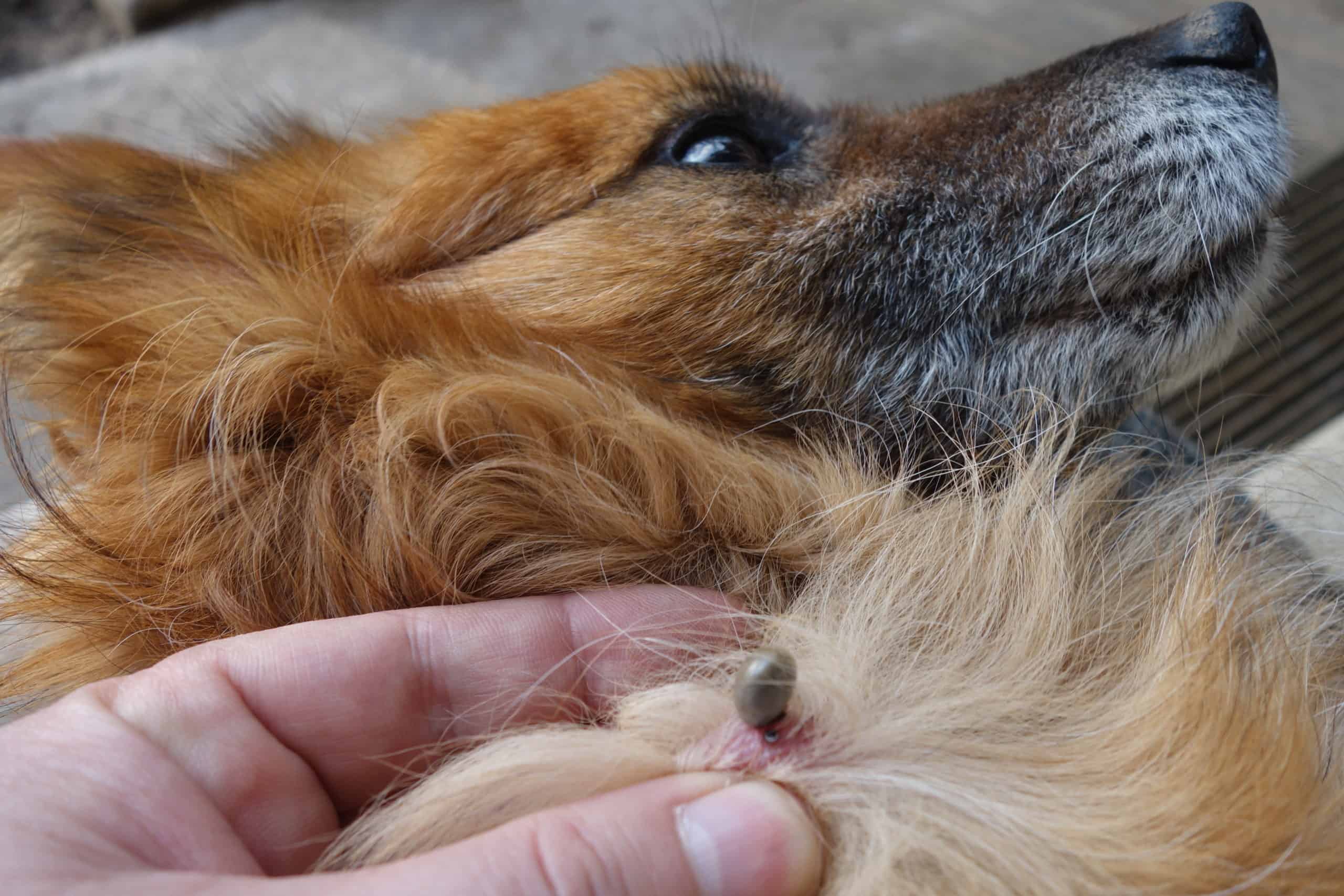
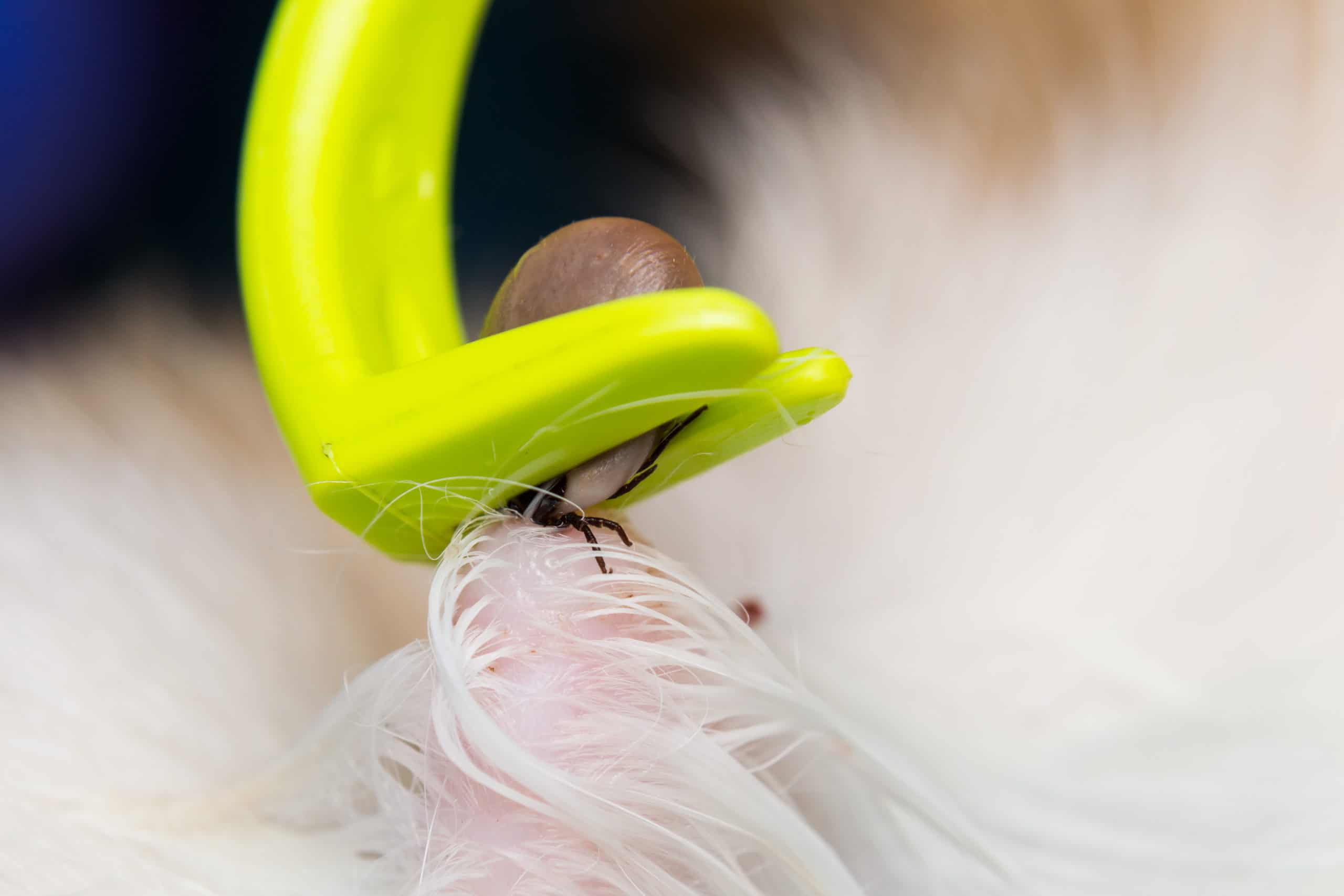
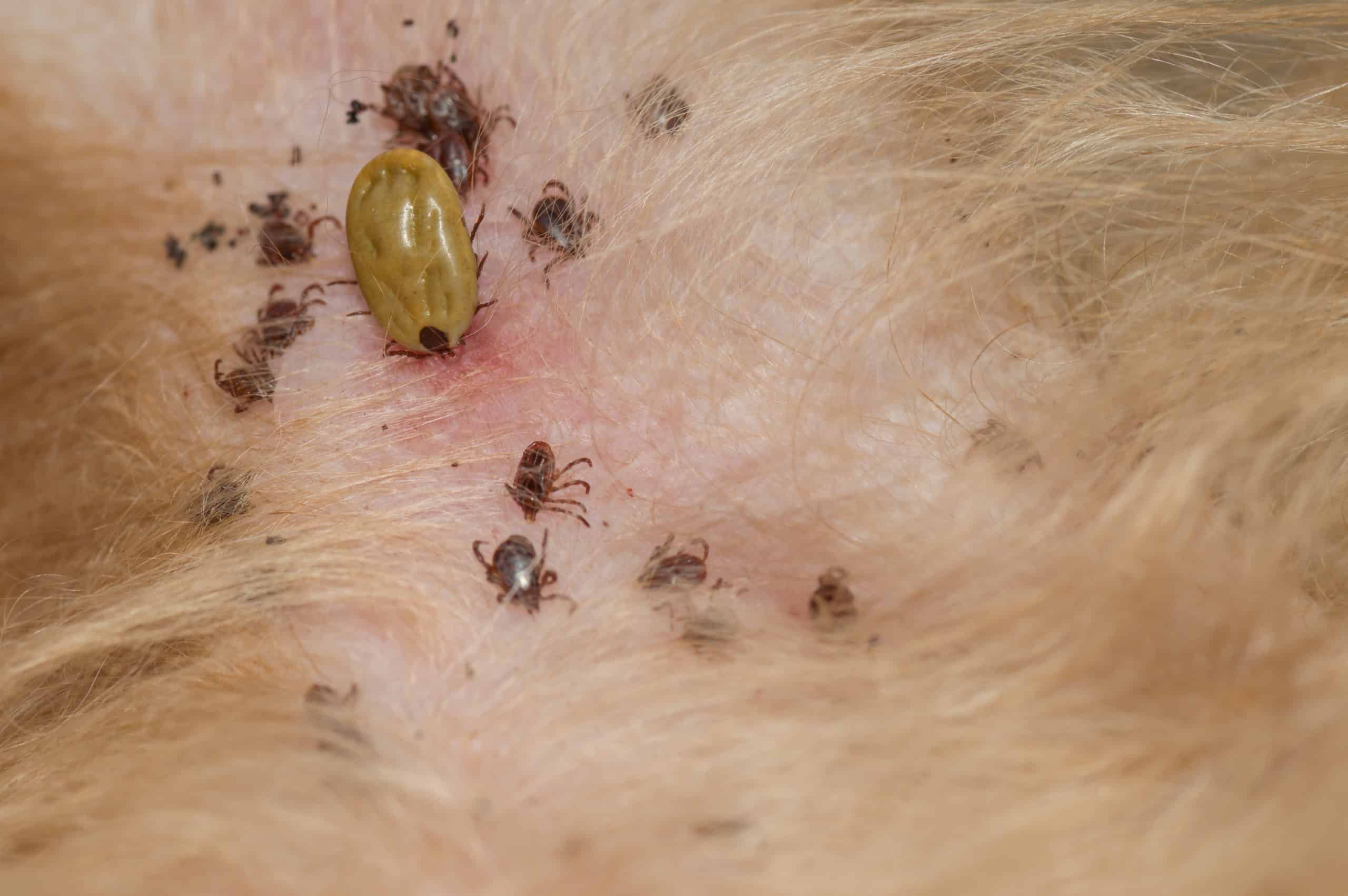
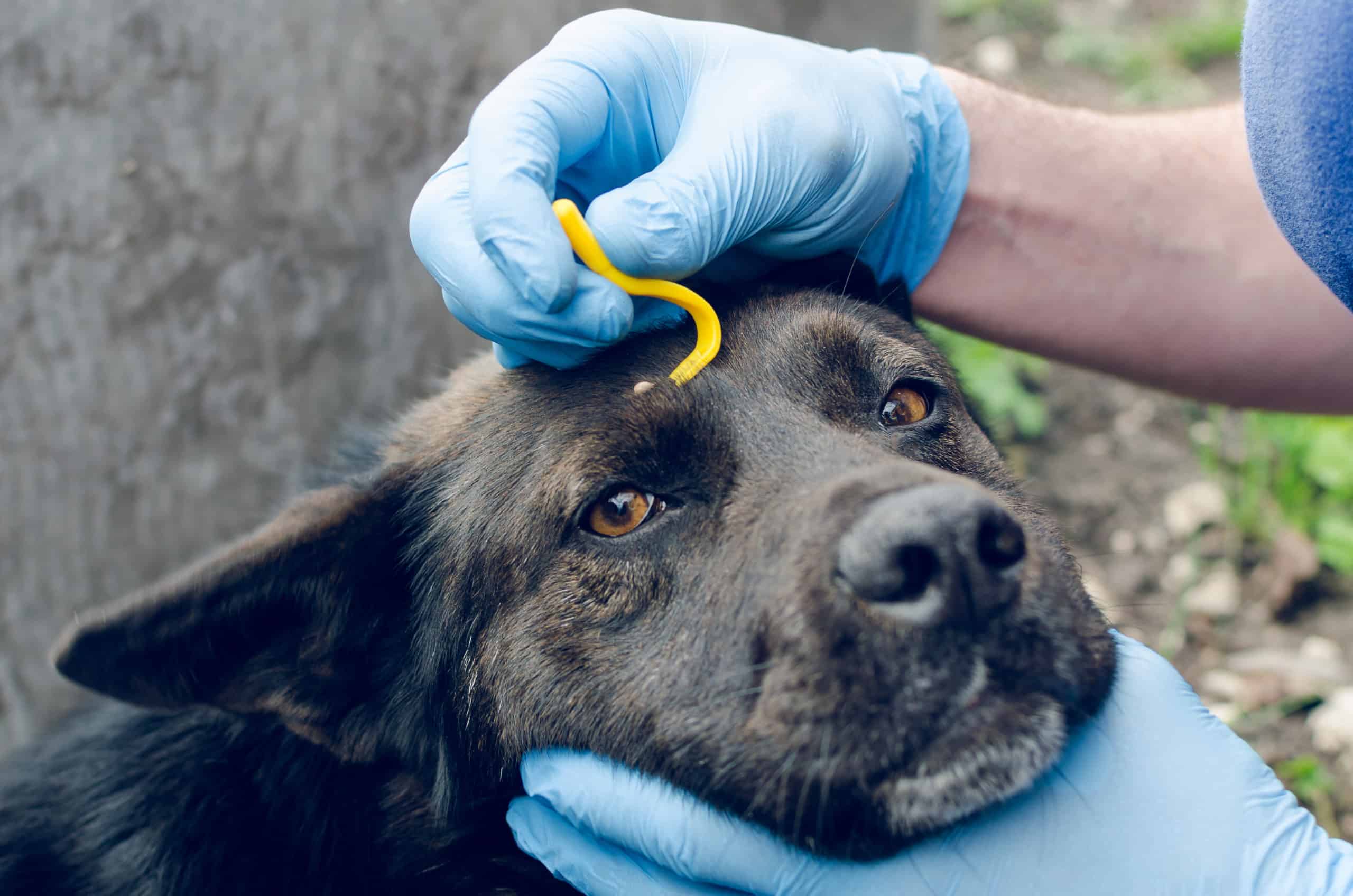

Ticks on Our Furry Friends
Ticks tend to plague pets just as much as they plague us. In the unfortunate case that your little buddy gets stuck with one of these ectoparasites, you will want to remove it as soon as possible as they can pass dangerous diseases to our pets as well. Along with passing lyme disease they can also cause blood loss, anemia, skin irritation, infection, or even tick paralysis if a tick is left feeding for a long enough time. In other serious cases, ticks can also pass a lethal infection to your furry friends called Cytauxzoonosis. Signs of this rapidly progressing and fatal infection include: high fever, loss of appetite, respiratory distress, jaundice, coma, and death. As such, it is incredibly important to monitor your pets for ticks whenever they may have come into contact with these dangerous pests, and take steps to remove them as soon as possible.
Incorrect removal of ticks can result in the head and mouth of the tick remaining underneath your pet’s skin which can lead to infection or a nasty rash. It could also end up pressing fluids from the tick into your furry friend, which can potentially infect them with diseases. As such, careful and proper removal of ticks is extremely important. If available, it is highly recommended that you use a tool designed for tick removal, but, if one is not available, you can use tweezers as a substitute. Make sure to hold your tool as close to the contact point as possible and with gentle but steady and firm traction, pull back straight away from the skin (do not twist).
After removing the tick, it is important to monitor your pet for any changes in behavior or appetite, or any other concerning symptoms that may show within the following two to three weeks. In the unfortunate case it appears your furry friend has fallen ill, be sure to bring them to the vet as soon as possible for treatment.

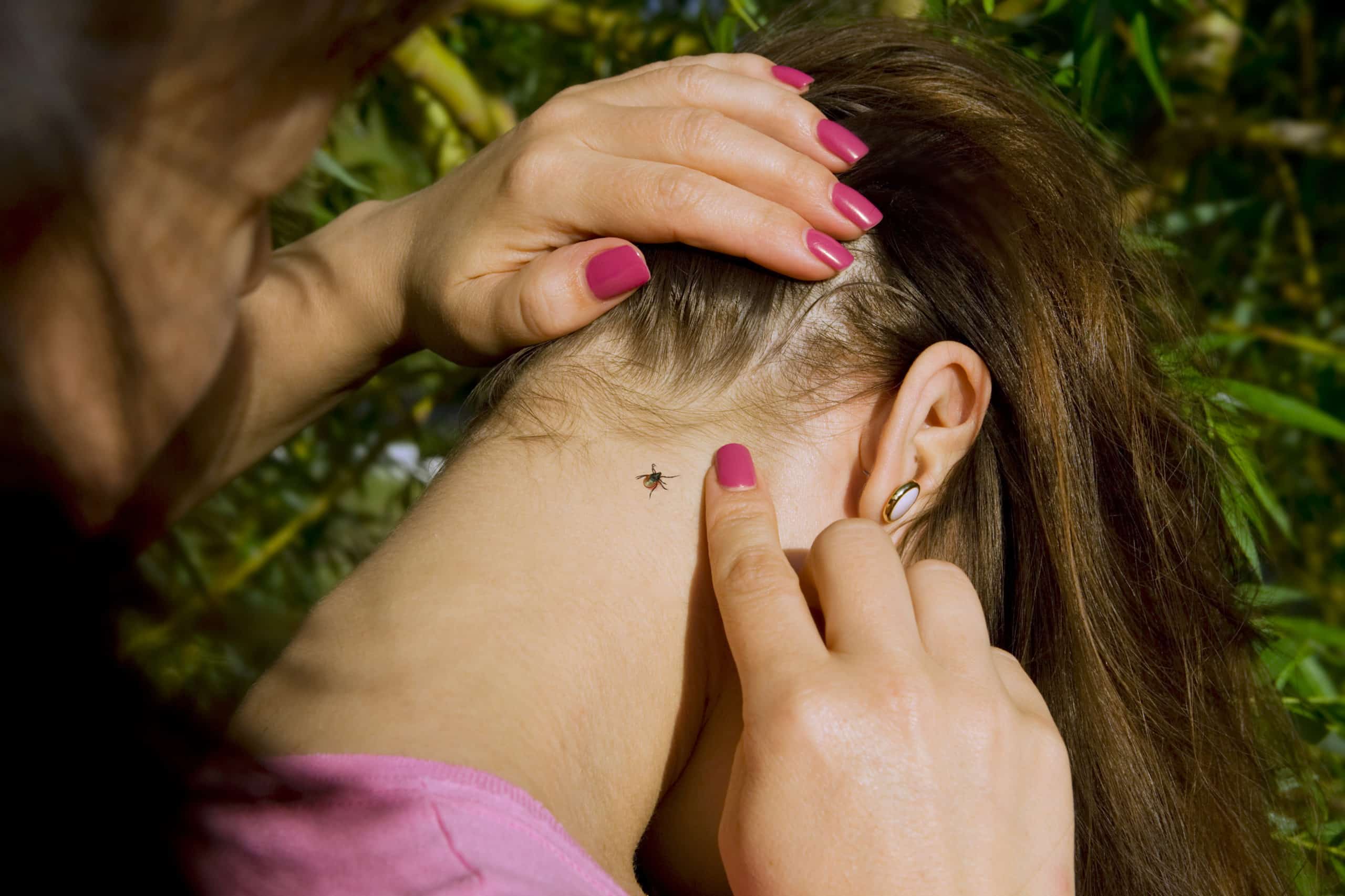
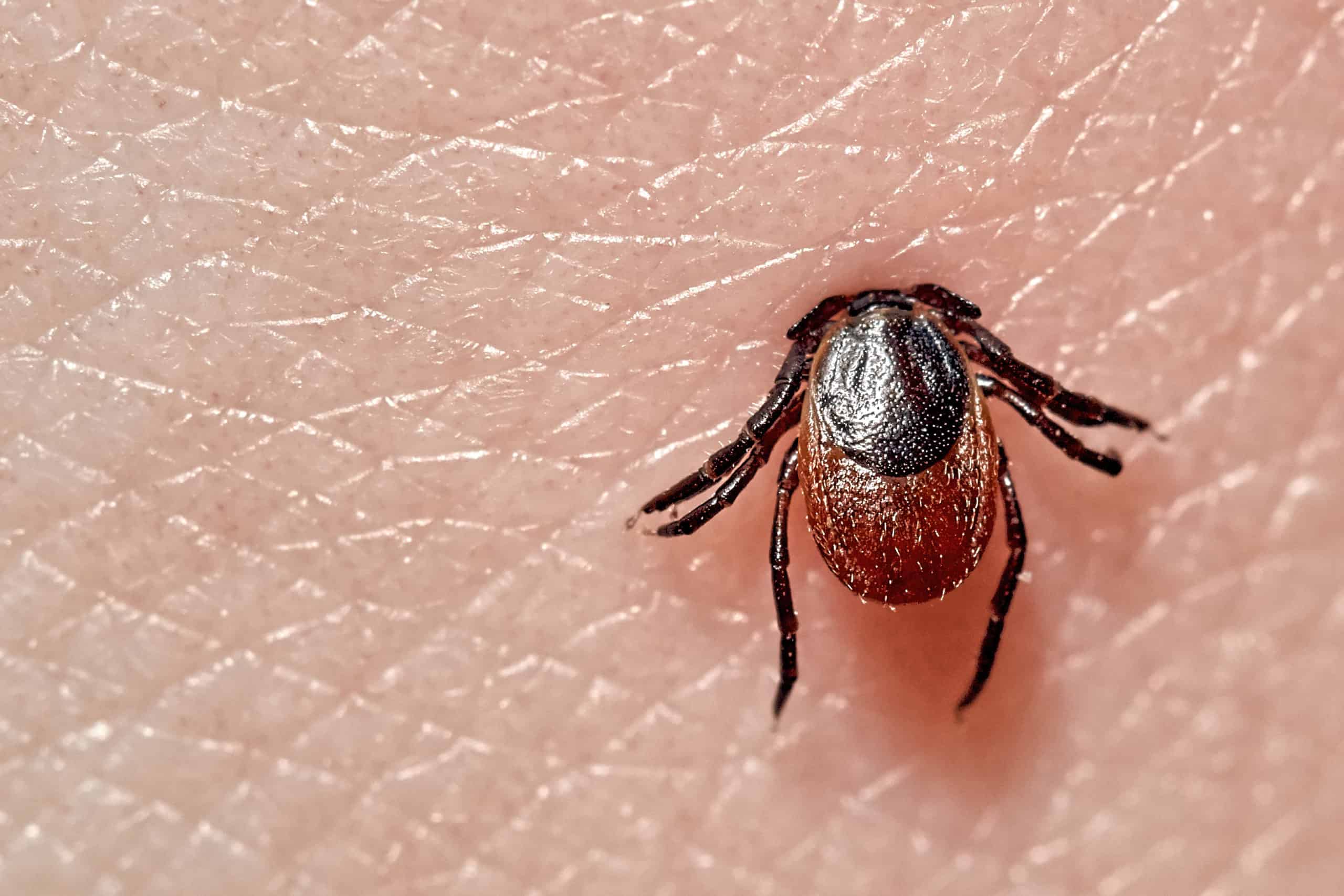
Checking for Ticks
While most common between April and September, tick exposure can actually occur year-round. Before you go outdoors, it’s important to be aware of where you may come into contact with ticks and properly protect your yard against these dangerous arachnids. Common areas where ticks are found include forests, fields, camping grounds, and any areas with heavy foliage.
After being in any of these locations where ticks are known or suspected to inhabit, it is extremely important to conduct a tick check. Look in any seams or folds of clothing, pockets, the belt region, any hats, and the lacing of your shoes. Be sure to also check under armpits and behind the knee.
If you happen to be with friends and family it is extremely helpful to check one another by looking at one another’s backs, the nape of the neck and even in the hair if necessary. It can also be helpful to check yourself over once more prior to a shower when clothing is no longer in the way, and be aware of any tiny bumps that you may feel on your scalp while washing your hair as it may be an attached tick.
On your pets, you will also want to examine their fur, trails, ears, etc. It is also extremely helpful to utilize preventative tick products such as Frontline Plus, K9 Advantix, or other tick/flea repellants recommended by your vet.

Checking for Ticks
While most common between April and September, tick exposure can actually occur year-round. Before you go outdoors, it’s important to be aware of where you may come into contact with ticks and properly protect your yard against these dangerous arachnids. Common areas where ticks are found include forests, fields, camping grounds, and any areas with heavy foliage.
After being in any of these locations where ticks are known or suspected to inhabit, it is extremely important to conduct a tick check. Look in any seams or folds of clothing, pockets, the belt region, any hats, and the lacing of your shoes. Be sure to also check under armpits and behind the knee.
If you happen to be with friends and family it is extremely helpful to check one another by looking at one another’s backs, the nape of the neck and even in the hair if necessary. It can also be helpful to check yourself over once more prior to a shower when clothing is no longer in the way, and be aware of any tiny bumps that you may feel on your scalp while washing your hair as it may be an attached tick.
On your pets, you will also want to examine their fur, trails, ears, etc. It is also extremely helpful to utilize preventative tick products such as Frontline Plus, K9 Advantix, or other tick/flea repellants recommended by your vet.
Protect Your Family from Ticks
In Virginia we have our fair share of beautiful greenery, but while it may be very enjoyable in some ways, it can also put us all at a greater risk for ticks. The best way to protect yourself and your family from an onslaught of potentially dangerous tick bites, is by scheduling routine Tick Control Treatments for your home. Our tick treatment includes elimination of mosquitos and also helps to ward off fleas. Your local technician will do a complete treatment of your home, even eliminating areas of safe harbor for mosquitos around your yard, to best safeguard your family and home from those pesky vectors of disease.
Call us today for top tick protection!



Protect Your Family from Ticks
In Virginia we have our fair share of beautiful greenery, but while it may be very enjoyable in some ways, it can also put us all at a greater risk for ticks. The best way to protect yourself and your family from an onslaught of potentially dangerous tick bites, is by scheduling routine Tick Control Treatments for your home. Our tick treatment includes elimination of mosquitos and also helps to ward off fleas. Your local technician will do a complete treatment of your home, even eliminating areas of safe harbor for mosquitos around your yard, to best safeguard your family and home from those pesky vectors of disease.
Call us today for top tick protection!
Want to Guard Your Yard Against Ticks?
Your Safety is Our Priority
Eco Friendly
All of our pest control products we use are Eco Friendly and safe for the environment.
Pet Safe
Our products are pet-safe and our Techs love getting that special welcome from their friends.
Family Safe
Rest Easy. Our products are safe for the full family, even that new little addition you might have.
Rest Easy
Our entire Team has been certificated and background checked for your safety.
Highest Rated
We love our customers and they showed us the love with over 12,000+ 5 Star Reviews.
Maintained Plans
With Green Pest Services Quarterly Service you’re protected from pests 365 days a year.
Award Winning Service







“I have been using Green Pest Services for 4 years and am very happy with their service. They treat inside and outside of my house quarterly and re-treat as needed at no additional cost. I also like that their products are environmentally friendly. I highly recommend Green Pest Services to others!!!” -Linda
– Linda
Chantilly, VA
Feel Good About
Your Pest Control
Critters and insects don’t belong in your home, no matter how much you love nature. But that doesn’t mean your pest control technician has to wipe out half the neighborhood as a response. With our knowledge and experience, you’ll get a quicker, healthier result than many other pest control companies can provide. And with our prevention methods, you won’t be seeing pests in your home.
So if you want those ants out of your kitchen, those mice out of your closet, those bed bugs out of your sofa, we are your Alexandria pest control experts. We will keep you and your home safe from both pests and chemicals. Give us a call today to set up an appointment.

“I have been using Green Pest Services for 4 years and am very happy with their service. They treat inside and outside of my house quarterly and re-treat as needed at no additional cost. I also like that their products are environmentally friendly. I highly recommend Green Pest Services to others!!!” -Linda
– Linda
Chantilly, VA
Feel Good About
Your Pest Control
Critters and insects don’t belong in your home, no matter how much you love nature. But that doesn’t mean your pest control technician has to wipe out half the neighborhood as a response. With our knowledge and experience, you’ll get a quicker, healthier result than many other pest control companies can provide. And with our prevention methods, you won’t be seeing pests in your home.
So if you want those ants out of your kitchen, those mice out of your closet, those bed bugs out of your sofa, we are your Alexandria pest control experts. We will keep you and your home safe from both pests and chemicals. Give us a call today to set up an appointment.





